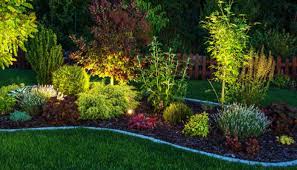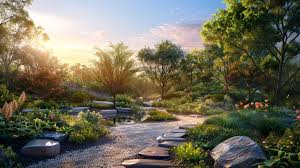Landscaping is more than just planting flowers and trees. It’s about creating an outdoor space that is both functional and aesthetically pleasing. To achieve this, a harmonious blend of hardscape and softscape elements is crucial.
Hardscape refers to the non-living elements in your landscape, such as:
- Patios and walkways: Providing pathways and gathering spaces.1
- Retaining walls: Controlling slopes and adding visual interest.2
- Decks: Creating elevated outdoor living areas.3
- Fences and gates: Defining boundaries and providing privacy.
- Water features: Adding the soothing sounds and visual appeal of water.4
- Outdoor lighting: Enhancing safety and creating ambiance.
Softscape, on the other hand, encompasses the living elements of your landscape, including:
- Trees and shrubs: Providing shade, privacy, and visual interest.5
- Flower beds and borders: Adding color, texture, and fragrance.6
- Groundcovers: Suppressing weeds and adding a layer of greenery.
- Lawns: Providing a soft surface for play and relaxation.7
- Vegetable gardens: Adding a touch of self-sufficiency and beauty.8
The Art of Integration
The key to successful landscaping lies in seamlessly integrating these two elements. Here are some key considerations:
- Functionality and Flow:
- Define pathways: Create clear and inviting pathways that connect different areas of your yard.9 Use materials like natural stone, brick, or gravel to complement the surrounding landscape.
- Consider traffic flow: Design pathways and patios to accommodate foot traffic and prevent congestion.10
- Create usable spaces: Designate areas for specific activities, such as a dining area on the patio, a play area for children, or a quiet reading nook.
- Visual Harmony:
- Color palette: Choose hardscape materials that complement the colors of your plants and flowers. For example, a gray stone patio can beautifully contrast with vibrant blooms.
- Texture and contrast: Create visual interest by combining different textures. Smooth stone pavers can be juxtaposed with the rough texture of a natural rock wall.
- Balance and symmetry: Achieve a sense of balance by distributing hardscape elements evenly throughout the landscape. Consider using symmetrical or asymmetrical designs to create visual harmony.
- Scale and Proportion:
- Consider the size of your property: Avoid overwhelming a small space with large hardscape features.
- Choose appropriate materials: Select materials that are proportional to the size of your house and yard.
- Create visual hierarchy: Use larger hardscape elements to anchor the space and guide the eye.
- Plant Selection and Placement:
- Choose plants that thrive in your climate: Select plants that are well-suited to your local conditions, including soil type, sunlight, and water availability.
- Consider plant size and growth habits: Choose plants that will mature to the appropriate size for your space and won’t overcrowd hardscape elements.
- Create focal points: Use strategically placed trees, shrubs, and flowering plants to draw attention to specific areas of your landscape.
- Water Features:
- Add the soothing sounds of water: Incorporate a water feature such as a pond, fountain, or stream to create a tranquil atmosphere.
- Consider the size and style of your water feature: Choose a water feature that is appropriate for the size and style of your home and landscape.
- Maintain water quality: Regularly clean and maintain your water feature to ensure healthy aquatic life and prevent mosquito breeding.11
- Outdoor Lighting:
- Illuminate pathways and walkways: Install path lights to ensure safety and guide visitors through your landscape at night.12
- Highlight focal points: Use spotlights to illuminate trees, shrubs, and other landscape features.
- Create ambiance: Install string lights or lanterns to create a warm and inviting atmosphere for evening gatherings.
- Sustainability Considerations:
- Choose eco-friendly materials: Select recycled or locally sourced materials for your hardscape features.
- Conserve water: Install drought-tolerant plants and use efficient irrigation systems.
- Minimize environmental impact: Avoid using pesticides and herbicides whenever possible.
Examples of Successful Hardscape and Softscape Combinations:
- A Japanese Zen Garden: This minimalist style emphasizes simplicity and tranquility.13 It features carefully raked gravel, smooth stones, and a few strategically placed plants, such as bonsai trees and bamboo.
- A Mediterranean Courtyard: This style incorporates elements such as terracotta pots, stone walls, and fragrant herbs like rosemary and lavender.
- A Modern Minimalist Landscape: This style features clean lines, geometric shapes, and a limited palette of plants.14 Hardscape elements such as concrete, steel, and glass are often used to create a sleek and contemporary look.
Creating a Personalized Landscape
Ultimately, the most successful landscapes are those that reflect the unique personality and lifestyle of the homeowner. By carefully considering the interplay of hardscape and softscape elements, you can create an outdoor space that is both beautiful and functional.
Beyond the Basics: Adding Unique Touches
- Incorporate vertical elements: Use climbing plants to adorn trellises, fences, and walls.
- Create a fire pit or outdoor fireplace: Extend your enjoyment of your outdoor space into the cooler months.
- Add a touch of whimsy: Incorporate decorative elements such as sculptures, bird baths, or wind chimes.
- Consider the views: Frame views of your surrounding landscape with strategically placed trees and shrubs.
By thoughtfully combining hardscape and softscape elements, you can transform your outdoor space into a true extension of your home – a place to relax, entertain, and connect with nature.
Remember: Landscaping is an ongoing process. Regularly maintain your plants, adjust your irrigation system as needed, and make changes to your landscape as your needs and preferences evolve. With a little care and attention, you can create an outdoor oasis that will bring you joy for years to come.
This article provides a general overview of combining hardscape and softscape elements in your landscaping ideas. It is always recommended to consult with a professional landscape designer to create a customized plan that meets your specific needs and preferences.








